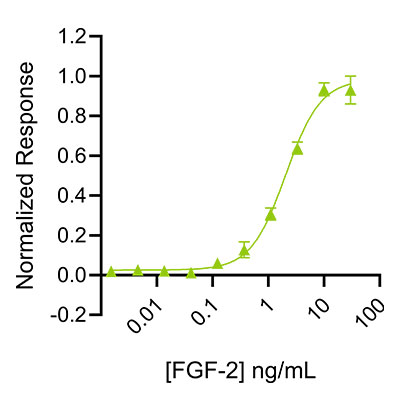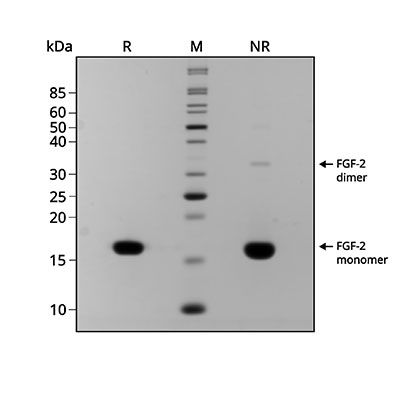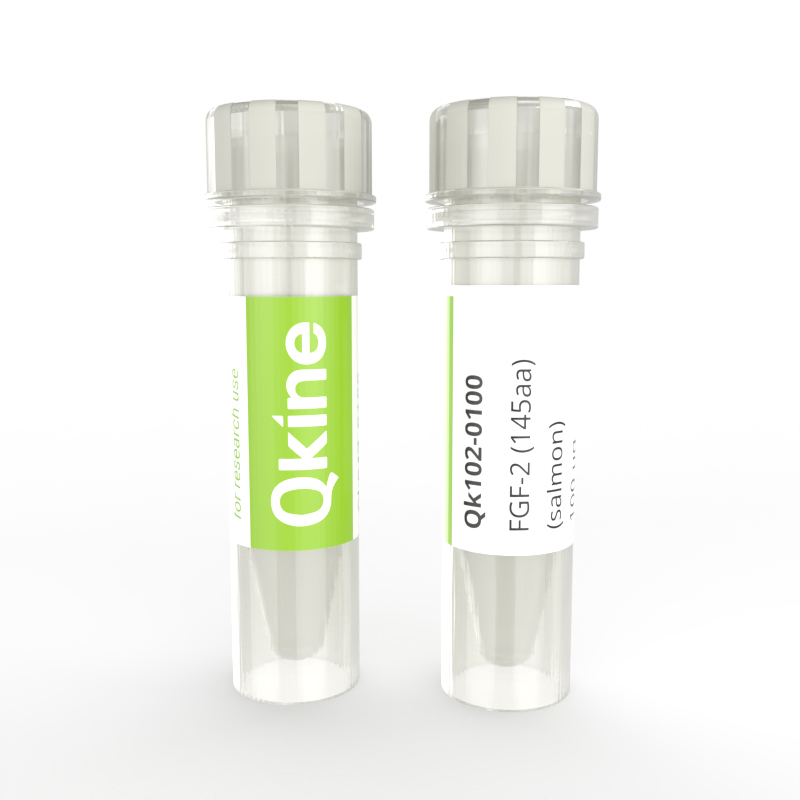Currency
Recombinant salmon FGF-2 (145 aa) protein (Qk102)
Recombinant salmon FGF-2 protein 145 aa (bFGF/basic FGF) for the development of optimized serum-free culture media for species-specific Atlantic salmon (Salmo salar) in cellular agriculture protocols and veterinary research applications. This shorter form of FGF-2 is used in comparative cell culture media optimization studies alongside Qk103, the 154 aa form of salmon FGF-2.
FGF-2 is used extensively in the maintenance and proliferation of induced pluripotent (iPSC) and embryonic stem cells (ESC) and for enhancement of proliferation in primary salmon cell culture. Receptor binding affinity and efficacy may differ depending on each species. Using a species-specific growth factor enhances receptor binding affinity, resulting in a lower concentration required in culture.
High purity 16.1 kDa FGF-2 / bFGF protein, animal origin-free (AOF) and carrier-protein free (CF).
Orders are typically shipped same or next day (except Friday).
Easy world-wide ordering, direct or through our distributors.
1000µg will be despatched as 2 x 500µg
Fast and free shipping.
Buy online with secure credit card or purchase order.
For any questions, please email orders@qkine.com
Summary
High purity salmon protein (Uniprot number: XP_014067501.1)
>98%, by SDS-PAGE quantitative densitometry
Source: Expressed in E. coli
16.1 kDa (Monomer)
Animal origin-free (AOF) and carrier protein-free
Manufactured in Cambridge, UK
Lyophilized from Tris/NaCl/CyS/mannitol
Resuspend in water at >100 µg/mL, prepare single-use aliquots, add carrier protein if desired, and store frozen at -20°C or -80°C
Featured applications
Expansion of salmon pluripotent, embryonic and mesenchymal stem cells
Cellular agriculture process development
Serum-free media development
Cell expansion
Proliferation of fibroblasts and endothelial cells
Tissue repair and regeneration
Basic fibroblast growth factor
bFGF
FGF-β
FGF2
Fibroblast growth factor-basic
HBGF-2
Salmon
Bioactivity

Recombinant salmon FGF-2 145aa activity is determined using the Promega serum response element luciferase reporter assay (*) in transfected HEK293T cells. Cells are treated in triplicate with a serial dilution of FGF-2 for 6 hours. Firefly luciferase activity is measured and normalized to the control Renilla luciferase activity. Data from Qk102 lot 204618. EC50 = 2.06 ng/mL (127 pM) *Promega pGL4.33[luc2P/SRE/Hygro] #E1340
Purity

Recombinant salmon FGF-2 145aa migrates as a major band at approximately 17 kDa (monomer) in reduced (R) and non-reduced (NR) conditions. The dimeric form is also observed at approximately 34 kDa in the non-reduced condition. No contaminating protein bands are present. The purified recombinant protein (3 µg) was resolved using 15% w/v SDS-PAGE in reduced (+β-mercaptoethanol, R) and non-reduced (NR) conditions and stained with Coomassie Brilliant Blue R250. Data from Qk102 lot #204618.
Further quality assays
Mass spectrometry, single species with the expected mass
Endotoxin: <0.005 EU/μg protein (below the level of detection)
Recovery from stock vial: >95%
We are a company founded and run by scientists to provide a service and support innovation in stem cell biology and regenerative medicine. All our products are exceptionally high purity, with complete characterisation and bioactivity analysis on every lot.
Protein background
Fibroblast Growth Factor 2 (FGF-2), also known as basic fibroblast growth factor (bFGF), is a key member of the fibroblast growth factor family, playing pivotal roles in various cellular processes such as growth, differentiation, and angiogenesis [1-3]. FGF-2 is a significant growth factor in embryonic development, tissue repair and wound healing. FGF-2 (154 aa) consists of 154 amino acids and exhibits a molecular weight of around 17 kDa. It comprises multiple isoforms and is characterized by a β-trefoil fold, stabilized by disulfide bonds, essential for biological activity.
FGF-2 plays a crucial role in stem cell research development by serving as a key component in maintaining the pluripotency and self-renewal of embryonic stem cells (ESCs) and induced pluripotent stem cells (iPSCs) [2]. FGF-2 is commonly used as a growth factor in cell culture media to maintain the pluripotent state of ESCs and iPSCs. It activates signaling pathways, including the mitogen-activated protein kinase (MAPK) pathway, which helps to sustain the expression of pluripotency-associated genes such as Oct4, Sox2, and Nanog. This prevents the differentiation of stem cells and allows for their expansion in vitro [2].
FGF-2 can be incorporated into scaffolds or hydrogels along with stem cells to promote their proliferation and differentiation within a three-dimensional environment. This holds great promise for the development of cultivated salmon protocols and serum-free media development in the cellular agriculture industry [4].
FAQ
FGF-2 is a signaling protein that plays a crucial role in regulating cell proliferation, differentiation, and survival in various biological processes, including development, tissue repair, and stem cell maintenance.
FGF-2 is found in multiple tissues and organs such as the brain, heart, kidneys, and skin, as well as in bodily fluids like blood and cerebrospinal fluid. It is produced by various cell types including fibroblasts, endothelial cells, and immune cells, and can act both locally and systemically to regulate cellular processes.
Cytokines are a broad category of signaling molecules that mediate communication between cells in the immune system and regulate various physiological processes. FGF-2 exhibits cytokine-like properties by influencing cell proliferation, differentiation, and survival, among other functions, in addition to its role in growth factor signaling.
The FGF-2 gene encodes the fibroblast growth factor 2 (FGF-2) protein, which is a member of the fibroblast growth factor (FGF) family. The FGF-2 gene is tightly regulated, dysregulation of FGF-2 signaling has been associated with cancer, cardiovascular disorders, and neurological conditions.
FGF-2 binds to fibroblast growth factor receptors (FGFRs) and heparan sulfate proteoglycans (HSPGs) on the cell surface.
The function of the FGF-2 receptor is to bind to FGF-2 ligands and transduce signaling cascades within the cell upon activation.
FGF-2 is commonly used in to maintain the pluripotency and self-renewal capacity of pluripotent stem cells, such as embryonic stem cells (ESCs) and induced pluripotent stem cells (iPSCs). It is added to the culture medium as a supplement to provide essential signaling cues necessary for stem cell maintenance. FGF-2 helps prevent the differentiation of pluripotent stem cells and maintains them in an undifferentiated state, enabling long-term culture and expansion.
Our products are for research use only and not for diagnostic or therapeutic use. Products are not for resale.



What others are saying
There are no contributions yet.